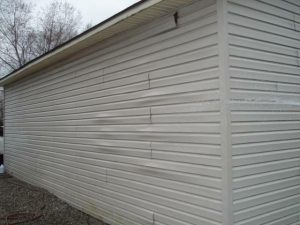Vinyl siding is America’s most popular siding material, accounting for more than one-third of installations across the country. It is inexpensive, relatively easy to install and low maintenance. Introduced in the 1950s, the early versions were susceptible to fading as well as becoming brittle in cold weather and buckling in hot weather. Vinyl siding has come a long way.
The siding is made from polyvinyl chloride (PVC), a comm on plastic used in many building materials. It may contain a number of additives. The quality varies, with the premium products tending to be thicker. Better vinyl siding comes with a 50-year warranty or a lifetime, prorated warranty. Light colors are common because they stand up better to heat and sunlight. Darker colors typically have more additives to help stabilize the vinyl.
on plastic used in many building materials. It may contain a number of additives. The quality varies, with the premium products tending to be thicker. Better vinyl siding comes with a 50-year warranty or a lifetime, prorated warranty. Light colors are common because they stand up better to heat and sunlight. Darker colors typically have more additives to help stabilize the vinyl.
The common problems that we see with vinyl siding include buckled and wavy siding, loose siding, flashing and caulking defects, mechanical damage and fading. In this article, we focus on buckled siding.
Buckled and Wavy Siding
Building settlement may cause siding to buckle, tear or come loose, although that is rare. Movement due to thermal stresses is far more common. All things expand and contract with temperature changes. PVC does so more than a lot of other materials. It has a high coefficient of thermal expansion. A 12-foot length of vinyl siding expands and contracts ½ inch or more.
Good installation helps prevent buckling and wavy siding. Here are some guidelines: • Nails should be driven through the center of the wide slots at the top of the siding. This allows the siding to expand and contract stress-free in the horizontal plane. • Nails should not be driven tight. The siding should hang on the nails to allow movement. • Fasteners should go through sheathing and at least ¾ inch into studs or furring. • There should be a fastener every 16 inches for horizontal siding, and every 12 inches for vertical panels. • Panels should overlap by at least 1 inch. • Adjacent panels should interlock. • There should be at least a ¼-inch clearance at all openings and stops. • Nailing strips between overlapping pieces should provide a ½-inch gap to allow for movement.
Poor installation can result in buckling, especially in hot weather. Home inspectors typically cannot see how the siding was installed, and siding that looks good in cold weather may deform in warm weather.
Vinyl siding damaged by reflected sun from nearby window.
The circumstances that cause this phenomenon include the following:
- An adjacent building has windows facing the vinyl siding.
- The windows are exposed to direct sunlight.
- The windows are double- or triple-glazed, and may be low-e glass.
- The outer pane of glass deflects inward due to barometric pressure differences, creating a concave surface like a magnifying glass, which concentrates the reflected sunlight.
- If the concentrated reflected light reaches the vinyl siding, the siding may overheat and deform.
- Vinyl temperatures can be well above 200°F. Vinyl siding typically begins to soften at roughly 160°F.
- The lower the angle of sun hitting the window, the more likely the problem is to occur. Spring, winter and fall come to mind, although low outdoor temperatures, of course, cool the siding.
- The closer the adjacent buildings, the more likely the problem is to occur. Problems most often happen with buildings less than 30 feet apart, although damage has been documented with up to 100 feet of separation.
What to Watch For
When inspecting any exterior cladding, you should be looking for surface anomalies. Where you see vinyl siding that is buckled or wavy, look for an adjacent building with significant window areas. You may see the bright star-shaped spots on the vinyl siding if it is sunny. Dark siding may be more vulnerable than light siding because it absorbs more heat.
Low-e glass may make the problem worse because it increases the amount of reflected ultraviolet (UV) light, although you will typically not be able to determine this. Argon-filled windows also may exacerbate the problem.
What to Do
Solutions include blocking the path of light from the windows to the siding. If the siding has been badly damaged, replacement may be necessary. Chlorinated polyvinyl chloride (CPVC) siding is a more expensive alternative, although it may not be completely immune to the issue.
Windows with capillary tubes between multiple panes, which are common in some Western states, have less deflection and thus are less susceptible to this problem.
If you have any questions about this or other home related issues, call or email us at 636.887.0774 or customerservice@mitchcollc.com
